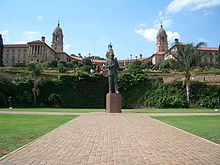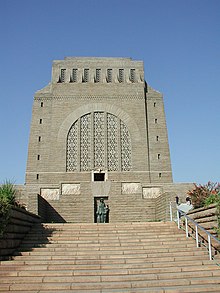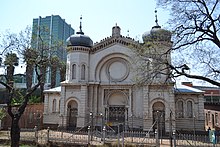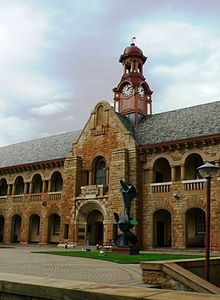Pretoria
| Pretoria | |||
|---|---|---|---|
|
|
|||
| Coordinates | 25 ° 44 ′ S , 28 ° 15 ′ E | ||
| Symbols | |||
|
|||
| Basic data | |||
| Country | South Africa | ||
| Gauteng | |||
| District | City of Tshwane | ||
| ISO 3166-2 | ZA-GP | ||
| height | 1367 m | ||
| surface | 687.5 km² | ||
| Metropolitan area | 2,174.6 km² | ||
| Residents | 741,651 (2011) | ||
| Metropolitan area | 2,921,488 (October 2011) | ||
| density | 1,078.7 Ew. / km² | ||
| Metropolitan area | 1,343.5 Ew. / km² | ||
| founding | 1855 | ||
| Post Code | 0001-0187 | ||
|
Pretoria skyline as seen from the Union Buildings
|
|||
Pretoria is the executive capital of the Republic of South Africa . However, in South Africa, the cities have Cape Town (with the seat of the Parliament as well as the six-seat of the government of January to June) and Bloemfontein (with the seat of the Supreme Court of Appeal - " Supreme Court of Appeal ") Capital function.
Pretoria is located in the northern part of Gauteng Province .
Since 2000, Pretoria part of the municipality of City of Tshwane Metropolitan Municipality .
In 2005 Pretoria won the LivCom Award in category E (over 750,000 inhabitants) and in that year was able to call itself the “most liveable city in the world”.
Name of the city and its pronunciation
- Afrikaans : Pretoria [ prəˈtʊə̯riɑ ]
- South African English : Pretoria [ prəˈtoːriə ]
- Setswana : Tshwane [ ˈʦʰwaːne ], Pitoria [ pˀiˈtˀoˈriːja ]
- Pedi : Tshwane [ ˈʦʰwaːne ]
- isiZulu : iPitoli [ ipˀiˈtˀoːli ]
- IsiXhosa : iTswani [ iˈʦˀɔ̯aːni ], iPitoli [ ipˀiˈtˀoːli ]
- South Ndebele : iPitori [ ipˀiˈtˀoːri ]
- Sesotho : Pitoriya [ pˀiˈtˀoˈriːja ]
- Siswati : iPitoli [ ipˀiˈtˀoːli ]
- Tshivenda : Tswane [ ˈʦʰwaːne ]
- Xitsonga : Pitori [ piˈtoːri ]
geography
location
Pretoria is located in the northeast of the country in the Gauteng Province, about 56 kilometers north of Johannesburg . The city is located in a warm, sheltered and fertile valley, which is surrounded by the chain of the Magaliesberg , at about 1370 meters above sea level.
Administrative districts
The City of Tshwane Metropolitan Municipality (CTMM) was established on December 5, 2000 when several municipalities in the greater Pretoria area merged.
The CTMM covers a large metropolitan area with the cities of Pretoria, Centurion , Akasia and the further outlying places Mabopane , Soshanguve , Atteridgeville , Ga-Rankuwa , Winterveld, Hammanskraal, Temba, Pienaarsrivier, Crocodile River and Mamelodi . The total area of the metropolitan municipality Tshwane is 2,199 km².
climate
In Pretoria the climate is subtropical, the sun shines an average of 300 days a year. The winter months are dry with less than 20 mm of precipitation; In winter, the monthly minimum temperatures drop to below 3 ° C, the maximum temperatures reach around 20 ° C. The summer months are quite humid with amounts of rain around 100 mm; the mean maximum values rise to almost 30 ° C in summer, the minimum values hardly drop below 15 ° C.
| Pretoria | ||||||||||||||||||||||||||||||||||||||||||||||||
|---|---|---|---|---|---|---|---|---|---|---|---|---|---|---|---|---|---|---|---|---|---|---|---|---|---|---|---|---|---|---|---|---|---|---|---|---|---|---|---|---|---|---|---|---|---|---|---|---|
| Climate diagram | ||||||||||||||||||||||||||||||||||||||||||||||||
| ||||||||||||||||||||||||||||||||||||||||||||||||
|
Average monthly temperatures and rainfall for Pretoria
Source: wetterkontor.de
|
|||||||||||||||||||||||||||||||||||||||||||||||||||||||||||||||||||||||||||||||||||||||||||||||||||||||||||||||||||||||||||||||||||||||||||||||||||||||||||||||||||||
flora

Pretoria is known for the 70,000 Jacaranda trees (Jacaranda mimosifolia) originally from the tropical part of South America , which line many streets in the urban area, but have also become native to other parts of southern Africa. In spring (from October) its mauve-colored flowers shape the cityscape. In Afrikaans, Pretoria is therefore also known as Jakarandastad .
The gardener JD Cilliers planted the first two jacaranda trees in his garden in the Sunnyside district in 1888. A Cape Town arborist imported the saplings from Rio de Janeiro, Brazil , and passed them on to Cilliers. Today these two trees are on the site of a primary school, Laerskool Sunnyside .
Towards the end of the 19th century, plant breeder James Clarke introduced jacaranda seeds from Australia to South Africa to cultivate jacaranda trees on a larger scale. In November 1906, he gave two hundred small trees to the Pretoria City Council, which had them planted in what was then the Kochstraat (now Bosmanstraat). Urban engineer Walton Jameson (later known as Jacaranda Jim ) took a liking to the trees and initiated a program to extend the planting of jacarandas as street trees to the entire city. In 1971 there were already 55,000 jacaranda trees in Pretoria.
Most of the jacarandas in the urban area have mauve flowers, with the exception of the white flowering trees that were planted along Herbert Bakerstraat in the Groenkloof district.
Between 1939 and 1964 the population of Pretoria celebrated the "Jacaranda Carnival" every year. After a long break, in 1985 they returned to this tradition. Since then there has been a festival with colorful processions, the highlight of which is the election of the "Jacaranda Queen".
history
Nguni -speaking settlers, later known as Ndebele and Matabele (derived from Sesotho : refugee ), were probably the first residents to recognize the location and fertility of the river valley, which later became the location of the city of Pretoria . The river was named Tshwane after one of its chiefs (from the Ndebele word for "little monkey"); it was later given the Afrikaans name Apiesrivier . During the Zulu rule in later Natal , even more people moved to this area under the leadership of General Mzilikazi , as they had been driven to flight by the Zulu chief Shaka in the course of the Mfecane .
Today's Pretoria was founded in 1855 by Marthinus Wessel Pretorius , who named the city after his father Andries Pretorius . This Pretorius, a general of the Voortrekker , was revered as a folk hero among the Boers because he had defeated the Zulu in the battle of the Blood River . Soon after, in 1860, Pretoria became the capital of the South African Republic (later Transvaal ) instead of the city of Potchefstroom . Around 1863 the place consisted of about 50 to 60 buildings and 300 inhabitants, among them many Germans and people of German origin . The appointment of Pretoria as the capital of the Transvaal marks the end of the Great Trek , the Boer departure from the Cape Colony in the 19th century.
During the First Boer War , the city was besieged by British units from December 1880 to March 1881. The war ended on August 3, 1881 with the signing of the Peace of Pretoria and the independence of the Transvaal.
The Second Boer War (1899–1902) sealed the end of the independent Boer republics and marked the beginning of British supremacy in South Africa. During this war Winston Churchill was imprisoned in Pretoria prison, but managed to escape to Mozambique . Pretoria was besieged again by British forces led by Frederick Sleigh Roberts . The Boer War ended in Pretoria with the signing of the Vereeniging Peace Treaty on May 31, 1902.
The Boer Republics of the Transvaal and Orange Free State were united with the Cape Colony and Natal to form the South African Union in 1910 . Pretoria became the capital of all of South Africa and Cape Town became the seat of the legislature . Until 1994 Pretoria was also the capital of the Transvaal Province. On October 14, 1931, Pretoria was granted city rights. When South Africa became a republic in 1961, the city remained the official capital.
The Marabastad district was partially demolished by 1920; from 1945 almost all residents were expelled and divided according to ethnic groups. In the 1960s and 1970s, the Lady Selborne neighborhood , where there was no racial segregation, was forcibly evacuated and demolished.
In 2000, Pretoria became part of the newly formed City of Tshwane Metropolitan Municipality . On March 8, 2005, the city council approved the motion to rename Pretoria Tshwane . However, this decision is not final. In particular the lobby group AfriForum is resisting the renaming. In August 2007, the South African Geographical Names Council (SAGNC) reaffirmed that Pretoria would keep its name.
population
741,651 people live in Pretoria and 2,921,488 in the metropolitan area of Tshwane (as of 2011). The census in 2011 showed that for Pretoria the following ethnic composition: White 52.5% Black 42.0%, Colored 2.5%, Indian / Asian 1.9% and others 1.2%.
In the original urban area in the pre-2000 borders, white South Africans still make up the majority of the population, while the suburbs of Pretoria are predominantly characterized by other ethnic groups. Soshanguve and Atteridgeville, for example, have a predominantly black and laudium traditionally an Indian majority . Social advancement requires the increasing mobility of the inhabitants, so that many South Africans of Indian origin have now settled in traditionally “white” suburbs.
Conversely, as almost everywhere in South Africa, an increase in the number of socially disadvantaged White, known armblankes or poor whites to observe. Above all, Afrikaans speakers without vocational training or with low qualifications who compete on the labor market with low-skilled people from other population groups are threatened with social exclusion through unemployment and poverty. It is estimated that there are around eighty slums in the city where impoverished whites live in precarious housing conditions.
After President Jacob Zuma, who has been in office since 2009, had previously paid two visits to the white slums of Bethlehem in the west of the city, he handed over houses built as part of social housing on the occasion of International Nelson Mandela Day on July 18, 2013 Residents of the Danville settlement, where poor whites from Bethlehem find a new home.
Jewish community
The first Jewish citizens settled in the city shortly after Pretoria was founded and in the following years contributed to the economic and industrial boom of the settlement. Prosecutor De Vries was the first Pretorian of the Jewish faith. As a respected citizen, he was elected to the Volksraad , the parliament of the South African Republic , and campaigned for Afrikaans to be recognized as the official language instead of Dutch. Another prominent figure in the Jewish community was Sammy Marks (1843–1920), an industrialist and financier of Lithuanian origin who immigrated to South Africa via England.
Most of the Jewish immigrants who settled in South Africa in the second half of the 19th century and the early 20th century had mostly not received a comprehensive education because of the social disadvantage in their home countries, especially in the then Russian Lithuania . The language skills of the Jewish newcomers in Pretoria were usually limited to their mother tongue, Yiddish , and only a few spoke English or even Dutch and Afrikaans. The retail trade offered an initial employment opportunity. Many Yiddish speakers ran small shops. During the Boer War, most of the Jewish Pretorians kept their neutrality, but individual citizens served as volunteers in the armed forces of the South African Republic and fought against the British.
The first Hebrew congregation was established between 1890 and 1895, and the first synagogue in Paul Krugerstraat was inaugurated in 1898. A second Jewish house of worship, the Great Synagogue, was built in 1922. Both synagogues are no longer used for Jewish services today. A Reformed synagogue, Temple Menorah , was dedicated in the early 1950s. Two schools were established for teaching Jewish children - the Miriam Marks School (1905) and the Carmel School (1959). Only the latter still exists today and is also used as a place of worship.
Jewish life in Pretoria flourished in the early 20th century when there were numerous Jewish sports clubs, charities, and youth groups in the city. In the years after 1948, the Jewish population decreased due to moves to Cape Town and Johannesburg and emigration to Israel . The property of the synagogue in Paul Krugerstraat was used in 1952, following expropriation proceedings initiated by the South African government, for the construction of the new Supreme Court, a courthouse that later held numerous trials against supporters of the black opposition movement, including the Treason Trial against Nelson Mandela , Walter Sisulu and numerous other people accused of high treason (August 1, 1958 to March 29, 1961) and the Rivonia trial from 1963.
Today the Jewish community in Pretoria has about 3,000 members. The local Reformed Jewish community shares its rabbi with its sister community in Johannesburg. It no longer has its own house of worship, so that meetings take place in the private apartments of the community members.
Culture and sights

The Kerkplein (English Church Square ) is the historic center of Pretoria. In the middle of the square is the statue of former President Paul Kruger . Several historical and architectural sights surround the Kerkplein : the Justisiepaleis (Palace of Justice), where the historically significant Rivonia Trial took place in 1963/64 , the Old Capitol Theater , the Ou Raadsaal (Old Parliament) and the Hoofposkantoor (main post office).
The Union Buildings in the northeast of the city center, seat of government from July to December, were built in the classical style from light sandstone by the architect Sir Herbert Baker . The building complex was built between 1910 and 1913 and is around 275 meters long. In May 1994 the first black President of the Republic of South Africa, Nelson Mandela , was sworn in here.
The Melrose House , a building that in the Victorian style was built in 1886, was the site of peace negotiations after the Second Boer War between the British and the Boers. In 1902 the Treaty of Vereeniging was signed in it. The Strijdomplein is a square in the center of the city, on which the oversized bust of the former Prime Minister Strijdom (1954-1958), after whom the square was named, stood until it collapsed due to a structural error in 1996 . The tallest structure in the city is the John Vorster Tower , a 198-meter high television tower .
Outside the city
- Botanical Garden
- Onderstepoort Nature Reserve
- Pioneer Open Air Museum
- Sammy Marks Museum near Zwartkoppies - the home of the South African industrialist Sammy Marks has been preserved as a museum and shows an insight into the world of the 19th century
- Tswaing meteorite crater (branch of the National Cultural History Museum )
- Wonderboom Nature Reserve
- zoo
Museums
- Fort Klapperkop - one of the three preserved forts in the city of Pretoria - now a museum of military history
- Fort Schanskop - one of the three preserved forts of the city of Pretoria - on the site of the Voortrekker monument - now a museum
- Fort West - one of the three preserved forts of the city of Pretoria - today a museum together with the surrounding area
- Krugerhaus - residence of the former President of the South African Republic Paul Kruger - now a museum
- Melrose House (conclusion of contract for the end of the Second Boer War )
- Museum of Geological Survey
- National Cultural History Museum with the branch of the Tswaing meteorite crater
- Transvaal Museum (Natural History Museum)
- Voortrekkerdenkmal - Boer monument about the time of the settlement by the white settlers
Economy and Infrastructure
education
Pretoria is one of the leading university cities in South Africa. The city is home to the Universiteit van Pretoria (University of Pretoria) and UNISA (University of South Africa), a comprehensive university and one of the largest distance universities in the world with over 250,000 students . The Universiteit van Pretoria is one of the universities in which Afrikaans was the dominant language of instruction for a long time. Today this educational institution is bilingual (Afrikaans and English).
traffic
Airports
OR Tambo Airport (formerly Johannesburg International Airport ), which is about 45 kilometers southeast of the city, and Lanseria International Airport south of Pretoria , act as Pretoria's passenger airport . The nearest airport for cargo and private planes is Wonderboom Airport .
train
The city's main train station is on the southern edge of the city center. It is served, among other things, by the trains in the network of the Metrorail Gauteng , which ensure a local transport connection with Johannesburg and the outskirts of the City of Tshwane. On August 2, 2011, Pretoria was connected to the Gautrain network. It extends to the eastern suburb of Hatfield. This high-speed local transport system runs on its own route in standard gauge and connects the city with OR Tambo Airport and on a second branch with Johannesburg.
Highways
The most important motorway in Pretoria is the N1 east bypass, which connects Johannesburg with Polokwane . It runs through the affluent eastern suburbs of the metropolitan area. The second major motorway is the N4 . It is a toll road and connects Pretoria with eMalahleni and Maputo ( Mozambique ) in the east and Rustenburg and Gaborone ( Botswana ) in the west. Other motorways in the city are the N14 towards Krugersdorp in the southwest and the R21 to OR Tambo International Airport in Kempton Park and the R80 in the northwest.
economy
Pretoria is an important industrial center in the country. The heavy industry with iron and steel construction, as well as the railway and mechanical engineering industries are located in Pretoria. Several automotive companies, such as BMW and Nissan , have manufacturing facilities in the city. The headquarters of the former South African Iron and Steel Corporation , ISCOR, which is now ArcelorMittal South Africa 's largest producer of steel in the country, was also located here. The munitions manufacturer Pretoria Metal Pressings , which belongs to Denel , is also based here. Pretoria Portland Cement Ltd. is also located here . based, which has offices in several African countries.
Menlyn Park is 115,000 square meters and is Pretoria's largest shopping mall . This complex has a stage for major events and a drive-in cinema on the roof of the building.
The Ford Motor Company of Southern Africa , which is one of the city's most important employers, is based in Pretoria . The factory used to operate under the name SAMCOR . Another automobile manufacturer was the Puma brand, originally from Brazil . The company Advanced Automotive Design produces cars in very small series.
Personalities
Sons and daughters of the town:
- Max Theiler (1899–1972), American biologist
- Jackie Moggridge (1922-2004), English aviator and first female flight captain
- Nigel Green (1924–1972), stage, film and television actor
- Moyra Caldecott (1927-2015), writer
- Seymour Papert (1928-2016), American mathematician
- Luki Botha (1930–2006), racing car driver
- Johnny Hubbard (1930-2018), football player
- Tony Maggs (1937–2009), racing car driver
- Herbert Roy "Tiger" Lance (1940-2010), cricketer
- Frederik van Zyl Slabbert (1940–2010), sociologist and politician
- Ernest Mothle (1941–2011), jazz musician
- Robert Calvert (1945–1988), poet, actor and musician
- Michael Levitt (* 1947), Nobel Laureate in Chemistry
- Dikgang Moseneke (* 1947), lawyer
- Austin Stevens (* 1950), documentary filmmaker and adventurer
- John Francis Thackeray (* 1952), paleoanthropologist
- Gail Kelly (née Currer) (* 1956), Australian bank manager
- Roger Michell (* 1956), theater, film and television director
- Carlo Mombelli (* 1960), jazz musician, composer and music teacher
- Arnold Vosloo (born 1962), actor
- Damon Galgut (* 1963), writer and playwright
- Tanja Jeschke (* 1964), German writer and literary critic
- George Fouché (* 1965), racing car driver
- Vusi Mahlasela (* 1965), singer, musician and composer
- Corrie Sanders (1966-2012), boxer
- Elon Musk (* 1971), entrepreneur, visionary and inventor
- Chris Haggard (* 1971), tennis player
- Sharlto Copley (* 1973), producer, actor and director
- Gerald Kyd (born 1973), British actor
- Werner Lupberger (* 1975), racing car driver
- Marcel Laponder (* 1978), biathlete
- Marissa van der Merwe (* 1978), racing cyclist
- Roland Schoeman (* 1980), swimmer
- Richard Sterne (* 1981), professional golfer
- Hendrik De Villiers (* 1981), triathlete
- Fourie du Preez (* 1982), rugby player
- Chanelle Scheepers (* 1984), tennis player
- Bianca Kriel (1985), actress
- Ashleigh Moolman (* 1985), racing cyclist
- Pierre Spies (born 1985), rugby player
- An-Li Kachelhoffer (* 1987), racing cyclist
- Tucker Vorster (* 1988), tennis player
- Jennifer Fry (* 1989), badminton player
- Cherise Taylor (* 1989), racing cyclist
- Emile Erasmus (* 1992), sprinter
- Louis Meintjes (* 1992), racing cyclist
- Keagan Girdlestone (born 1997), racing cyclist
Web links
- Official site of the City of Tshwane Metropolitan Municipality (English)
- Tourist information about Pretoria (English)
- Radio station Jacaranda 94.2 with live stream (English and Afrikaans)
- Pretoria News (English daily newspaper Pretorias)
- Local weekly magazine (English and Afrikaans)
Individual evidence
- ↑ The International Awards for Liveable Communities: The Results 2005 (English), accessed April 8, 2018
- ↑ Dawie Boshoff: Jakarandastad four fees . In: Suid-Afrikaanse Panorama , Volume 35, Number 2 (March / April 1990), p. 73
- ↑ Boshoff (1990), p. 75
- ↑ Boshoff (1990), p. 73
- ^ Christian Putsch: South Africa: Tshwane or Pretoria? The fight for the capital. In: welt.de . February 8, 2010, accessed October 7, 2018 .
- ↑ a b 2011 Census , accessed April 8, 2018
- ↑ BBC News Magazine, May 19, 2013: Do white people have a future in South Africa? Retrieved July 15, 2014
- ^ South Africa Government Online: President Jacob Zuma on Nelson Mandela Day, July 14, 2013. Retrieved July 15, 2014 ( Memento of July 1, 2014 in the Internet Archive )
- ^ Support Association for Zionism - History of Pretoria Jewry. Retrieved on July 16, 2014 ( Memento of the original from July 27, 2014 in the Internet Archive ) Info: The archive link was inserted automatically and has not yet been checked. Please check the original and archive link according to the instructions and then remove this notice.









